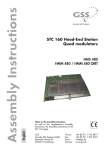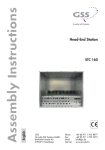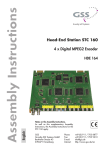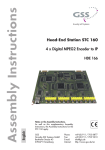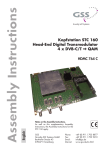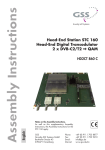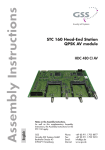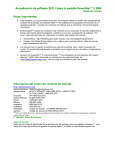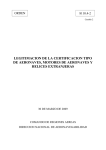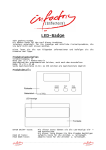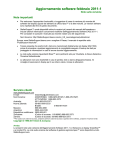Download A sse m b ly In stru ctio n s Assembly Instructions English
Transcript
STC 160 Head-End Station COFDM AV module HDCT 460 AV Notes on the Assembly Instructions. As well as this supplementary Assembly Instructions, the Assembly Instructions for the STC 160 apply. English Assembly Instructions Grundig SAT SystEms GSS Grundig SAT Systems GmbH Beuthener Strasse 43 D-90471 Nuremberg Phone: Fax: Email: Internet: +49 (0) 911 / 703 8877 +49 (0) 911 / 703 9210 [email protected] www.gss.tv Contents 1 Safety regulations ......................................................................................................3 2 General information ...................................................................................................3 2.1 Scope of delivery .........................................................................................3 2.2 Technical data .............................................................................................4 2.3 Description ..................................................................................................5 3 Installation .................................................................................................................6 3.1 Installing the digital module ...........................................................................6 3.2 Connecting the digital module .......................................................................8 4 The control panel at a glance ......................................................................................9 4.1 Menu items ..................................................................................................9 4.2 Functions of the control panel buttons .............................................................9 5 Programming ...........................................................................................................10 5.1 Preparation ................................................................................................10 5.2 The menus at a glance ............................................................................... 11 5.2.1 The menus for channel strips “A” and “D” ............................................ 11 5.2.2 The menus for channel strip “B” .........................................................13 5.2.3 The menus for channel strip “C” .........................................................14 5.3 Programming a module ...............................................................................15 Selecting the module / channel strip ...................................................15 5.3.1 Programming channel strips “A” and “D” .............................................16 Setting the input channel ...................................................................16 Setting the hierarchical modulation .....................................................18 Automatic channel search / station filter..............................................19 Selecting the audio stream for a TV channel ........................................20 Setting the volume level ...................................................................21 Setting the identification of the stereo / dual tone .................................21 Adjusting the picture format, teletext mode...........................................22 Activating teletext subtitle pages and setting the standard .....................22 Storing data .....................................................................................24 5.3.2 Programming channel strip “B” ...........................................................25 Automatic channel search / station filter..............................................25 5.3.3 Programming channel strip “C” ..........................................................26 Selecting a tuner...............................................................................26 Automatic channel search / station filter..............................................27 -2- 1 Safety regulations Please read the safety regulations listed in the assembly instructions for the STC 160 head-end station which pertain to this module. Take precautions to prevent electrostatic discharge when working on the device! 2 General information 2.1 Scope of delivery 1 HDCT 460 AV module 1 AV cable 1 CD (assembly instructions) -3- 2.2 Technical data The requirements of the following are met: 73/23/EEC, 89/336/EEC The product fulfils the guidelines and standards for CE labelling. HF input: Frequency range: Level: Input impedance: Return loss: Channel input: 177.5 … 858 MHz 45 dBµV … 90 dBµV 75 Ω typ. 8 dB C 05 … C 69, incl. S 11 … S 41 Output specifications: Audio Noise voltage ratio rated (DIN 45633): Non-linear distortion factor: Frequency range: Level at -12 dB: Impedance: typ. 60 dB typ. 0.6 % 20 Hz … 15 kHz typ. 500 mVrms 1 kΩ Video Signal-to-noise ratio: Level (75 Ω): Impedance: Connections: HF inputs: Loop through outputs: Connection strip (20-pin): AV output: ≥ 54 dB (rated) typ. 1 Vpp 75 Ω 2 IEC sockets 2 IEC sockets For supply voltages and control circuits 26-pin socket -4- 2.3 Description The COFDM AV module HDCT 460 AV, in the following called digital module, has a COFDM AV converter which simultaneously converts four COFDM modulated channels into AV signals using two DVB-T tuners. The digital module has two DVB-T inputs. Via the AV interface, the decoded video and audio signals are fed to the corresponding modulator module. From there, they are fed to the HF output collector of the head-end station, through which the level of the output signal can be adjusted via the software in the head-end station. The channel strips “A” “B”, “C” and “D” can be individually programmed. This means it is possible to select up to 4 channels out of two data streams. The following table shows the allocation of the selectable number of channels to the tuners: Number of channels Tuner “A” Tuner “D” 3 1 2 2 For example, if three channels from tuner “A” will be used, one channel from tuner “D” can be used. If two channels from tuner “A” will be used, two channels from tuner “D” can also be used. Signal transfer principle: TUNER A Channel strip “A“ Channel strip “B“ Channel strip “C“ Channel strip “D“ TUNER D The operating software of the digital module can be updated via the 9pin SUB-D socket on the control unit of the head-end station using a PC or notebook and the Software “BE-Flash”. You can find the current operating software on the website “www.gss.tv”. This digital module is designed exclusively for use in the STC 160 head-end station. -5- 3 Installation Caution Before installing or changing a module, switch off the head-end station or unplug the power cable from the mains power socket. Take precautions to prevent electrostatic discharge when working on the device! • Open the housing of the head-end station according to the instructions in the STC 160 assembly instructions. 3.1 Installing the digital module Caution – Always position modules which belong together next to each other. The digital module must be installed to the left of the modulator module. – Insert the digital module in a long numbered groove in front of a contact strip on the board at the rear wall of the housing. The shorter not numbered grooves without a contact strip on the board at the rear wall of the housing are for add-on modules only. -6- Note: Slots 1 (digital module) and 2 (modulator module) are shown in the illustration. The open slots in between (without a contact strip on the board at the rear wall of the housing) are intended for add-on modules. • Insert the digital module in grooves A and B of an open slot (with contact strip on the board at the rear wall of the housing) next to the associated modulator module. • Gently slide the digital module into the head-end station and ensure that it makes contact with the contact strip on the board at the rear wall of the housing. -7- 3.2 Connecting the digital module HF input ”A“ HF input ”D“ • Using the AV cable C, connect the digital module to the modulator module. • Connect the HF inputs “A” and “D” on the digital module with the corresponding cable inlets using cables made on-site. -8- 4 The control panel at a glance 4.1 Menu items Program the digital module using the buttons on the head-end station control unit. The menus appear on the two-line display of the control unit. The parameters and functions to be set are underlined. You can use the M button to select the following menu items: – – – – – – – – – – Input channel Tuner selection (channel strip “C” only) Hierarchical modulation Automatic channel search / station filter Audio stream of the TV channel Audio output level Stereo identification / audio type selection Picture format (WSS) / teletext Teletext subtitle page Store 4.2 Functions of the control panel buttons M S S M – – – – To To To To move the cursor adjust values and functions store the programmed data switch to the next menu -9- 5 Programming 5.1 Preparation • Connect the digital module to a programmed modulator module. • Connect the test receiver to the HF output on the modulator module. • Adjust the test receiver to the output channel of the channel strip to be set: Digital module – channel strip “A” —> modulator module – channel strip “A”, Digital module – channel strip “B” —> modulator module – channel strip “B”, Digital module – channel strip “C” —> modulator module – channel strip “C”, Digital module – channel strip “D” —> modulator module – channel strip “D”. Note: – Entries in the settings menus can be stored by pressing the S button. —> You will be returned to the menu item “Selecting the module / channel strip”. - 10 - 5.2 The menus at a glance 5.2.1 The menus for channel strips “A” and “D” Ein/On SETUP BE160 V2 Bx 1A TWIN-SAT Böx 4 TWIN-SAT QUAD Bx 1B C5-12,S3-24 C07 C5-12,S3-24 C07 Das Erste V2 QUAD Bx 1A arte V2 M Bx 1A INPUT C06 (184.5) OK / M Bx 1A Priority: INPUT high / M Bx 1A 01/04 + TV / arte M AUDIO Bx 1A / 01 / 02 “deu” Anzeige des Menüs nur bei Auswahlmöglichkeit mehrerer Untertöne. This menu is only displayed if several sub sound signals are selectable. M Bx 1A AUDIO Level 0 dB / -26 … 6 dB M Bx 1A AUDIO mpeg DUAL norm / / M - 11 - Bx 1A VIDEO WSS off TXT on / / M Bx 1A SUBTITLE SUBTITLE Bx 1A off 150 txt M west / / M SUBTITLE Bx 1A dvb –– / / M Bx 1A MEMORY S => STORE M CANCEL S - 12 - 5.2.2 The menus for channel strip “B” Bx 1B Bx 1A TWIN-SAT Böx 4 TWIN-SAT QUAD Bx 1C C5-12,S3-24 C07 C5-12,S3-24 C07 ZDF V2 QUAD Das Erste V2 M Bx 1B 02/04+ TV / Das Erste M AUDIO Bx 1B / 01 / 02 “deu” Anzeige des Menüs nur bei Auswahlmöglichkeit mehrerer Untertöne. This menu is only displayed if several sub sound signals are selectable. M Bx 1B AUDIO Level 0 dB / -26 … 6 dB M Bx 1B AUDIO mpeg DUAL norm / / M Bx 1B VIDEO WSS off TXT on / / M Bx 1B SUBTITLE SUBTITLE Bx 1B off 150 txt M west / / M SUBTITLE Bx 1B dvb –– / / M Bx 1B MEMORY S => STORE M CANCEL S - 13 - 5.2.3 The menus for channel strip “C” Bx 1A TWIN-SAT Böx 4 TWIN-SAT QUAD Bx 1D C5-12,S3-24 C07 C5-12,S3-24 C07 Kabel eins V2 QUAD Bx 1C ZDF V2 M Bx 1C INPUT / TUNER Line D M Bx 1C 01/04 + TV ZDF M AUDIO Bx 1B / 01 / 02 “deu” Anzeige des Menüs nur bei Auswahlmöglichkeit mehrerer Untertöne. This menu is only displayed if several sub sound signals are selectable. M Bx 1C AUDIO Level 0 dB / -26 … 6 dB M Bx 1C AUDIO mpeg DUAL norm / / M Bx 1C VIDEO WSS off TXT on / / M Bx 1C SUBTITLE SUBTITLE Bx 1C off 150 txt M west / / M SUBTITLE Bx 1C dvb –– / / M Bx 1C MEMORY S => STORE M CANCEL S - 14 - 5.3 Programming a module • Switch on the head-end station. —> The display shows “SETUP BE160” and the software version of the head-end station (e.g. V 2). —> The output level of the output collector can be adjusted in the “SETUP” menu (see STC 160 assembly instructions). Ein/On SETUP BE160 V2 Bx 1A TWIN SAT Selecting the module / channel strip repeatedly if necessary to select the particular • Press module (Bx ...) or channel strip “A”, “B”, “C” or “D” to be programmed. QUAD Bx 1A arte V2 Bx 1A TWIN-SAT Böx 4 TWIN-SAT QUAD Bx 1B C5-12,S3-24 C07 C5-12,S3-24 C07 Das Erste V2 M • Press the M button to activate the channel strip. —> The display shows, for example, the “Bx 1A QUAD” menu. “Bx” indicates the slot “1” indicates slot no. 1 ”A” indicates channel strip A ”arte” name of the selected channel “V 2” software version of the module —> The programming procedure is the same for channel strips “A” and “D”. This will be explained in section 5.3.1. —> The programming procedures for channel strips “B” and “C” are explained from pages 25 and 26 respectively. - 15 - 5.3.1 Programming channel strips “A” and “D” • Press the M button: —> The “Setting the input channel” – “INPUT” menu is activated. Setting the input channel Note: – If “– –” appears in the second line of the display, there is no input signal present. Check the configuration of the antenna system and head-end station. – If the received signal is all right, “OK” is displayed. Bx 1A INPUT C06 (184.5) OK / M • Set the desired input channel by pressing the tons repeatedly or permanently. but- Notes: – Beside the input channel set the corresponding frequency is displayed. – The quality of the data stream received is indicated by two status LEDs: LED indicator Signal Green OK Red No signal - 16 - Status LED ”Tuner A“ Status LED ”Tuner D“ • Press the M button. —> The “Setting the hierarchical modulation” – “Priority” menu is activated. - 17 - Setting the hierarchical modulation In order to attain with less field strength a greater range for broadcasters, with DVB-T so-called “hierarchical modulation” is used. In this process, several data streams are modulated onto a DVB-T data stream using “Quadrature Amplitude Modulation” (QAM). The robust “High Priority” data stream (HP) with a lower data rate is modulated onto the more sensitive “Low Priority” data stream, which possesses a higher data rate. In good reception conditions, the receivers can receive both data streams; in poorer reception conditions, only the “HP” portion. Several receivers can be supplied simultaneously with various services via one channel. Bx 1A Priority: INPUT high / M • By pressing , set to “high“ or “low“ (not relevant in the case of standard modulation). • Press the M button. —> The “Automatic channel search / station filter” – e.g. “Bx 1A 01/04 + TV” menu is activated. - 18 - Automatic channel search / station filter In this menu, select the channel from the data stream that is to be made available through this channel strip. If the error message “no transponder” appears, no input signal is present. In this case, you should check the previous settings as well as the configuration of the receiving system. If the “scanning ...” message appears on the display, the table of received channels is being read. Please wait until this process is finished. As soon as the automatic channel search has found all of the TV or radio stations, the corresponding data appears in the display of the head-end station. Bx 1A 01/04 + TV / arte M Meaning of the indicators shown in this example: “01/04” – The first of a total of 4 TV channels is being shown or has been activated. “+” – The audio stream for the current TV channel is available in several languages. “TV” – The data on the display corresponds to a TV channel. “arte” – Station name Other possible indicators: “RA” – The data on the display corresponds to a radio station. “*“ – A star indicates that this TV or radio station is encoded. - 19 - Notes: —> For radio stations, the background of the screen of the connected TV or test receiver is darkened. —> If a service number (e.g. “SERVICE 131”) appears instead of “TV” or “RA”, this indicates that an unnamed station or an undefined data stream is being received. • Select the desired TV or radio station with the buttons. • Press the M button. —> If the selected channel is broadcast with two or more audio streams, the “Selecting the audio stream for a TV channel” – “AUDIO” menu will appear. Otherwise the “Setting the volume level” – “AUDIO Level” menu is activated (see page 21). Selecting the audio stream for a TV channel This menu only appears if the selected channel is broadcast with two or more audio streams (languages). In this menu, select the desired audio stream from the transport stream. AUDIO Bx 1A 01 / 02 “deu” / Anzeige des Menüs nur bei Auswahlmöglichkeit mehrerer Untertöne. This menu is only displayed if several sub sound signals are selectable. M • Use the buttons to select the audio stream you want. —> In the example the audio stream “01” of two available audio streams is selected. • Press the M button. —> The “Setting the volume level” – “AUDIO Level” menu is activated. - 20 - Setting the volume level In this menu, you can balance unequal volume levels of TV and radio stations in the various channel strips. Bx 1A AUDIO Level 0 dB / -26 … 6 dB M • Use the buttons to adjust the volume of the individual channel strips so that they are all balanced. • Press the M button. —> The “Setting the identification of the stereo / dual tone” – “AUDIO” menu is activated. Setting the identification of the stereo / dual tone In this menu, you can select whether the stereo audio identification is decoded from the VPS data or from the MPEG data stream. Further you can switch between the languages on TV stations with dual tone. Bx 1A AUDIO mpeg DUAL norm / / M • Using the buttons, select which data stream should be decoded “mpeg” or “VPS.” • Use the buttons to position the cursor under the dual tone code to be set. Use the buttons to switch between (“DUAL norm” or “DUAL swap”) audio streams (languages) for dual tone TV channels. • Press the M button. —> The “Adjusting the picture format, teletext mode” – “VIDEO WSS” menu is activated. - 21 - Adjusting the picture format, teletext mode You can activate the change picture format mode and switch teletext on or off in this menu. Bx 1A VIDEO WSS off TXT on / / M • To activate/deactivate WSS, use the buttons to select “on” or “off”. • To activate/deactivate teletext mode, use the buttons to position the cursor under teletext mode “TXT on” and use the buttons to select “off” or “on”. • Press the M button. —> The “Activating teletext subtitle pages and setting the standard” – “SUBTITLE” menu is activated. Activating teletext subtitle pages and setting the standard This menu allows subtitles transmitted in teletext to be displayed directly in the programme. To display the characters for Western or Eastern European languages, the corresponding character set “west” or “east” can be selected. Bx 1A SUBTITLE off SUBTITLE Bx 1A 150 txt M west / / M SUBTITLE Bx 1A dvb –– / / M • In the menu shown above, teletext subtitling is switched off (“off”). Use the button to switch on “txt” teletext subtitling if necessary or to switch it “off” using the buttons if it is already on. - 22 - If you do not want to change the setting, press the M button. —> The “Storing data” – “MEMORY” menu is activated (page 24). When teletext subtitling is switched on • Using the buttons, position the cursor under the digit of the page number to be set. Then use to set each of the three digits. • Using , position the cursor under teletext standard, e.g. “west” and use to select the teletext standard “west” or “east”. —> By repeatedly pressing , you can position the cursor under “txt” and switch “off” subtitles using . DVB programmes with subtitle pages • If you want to activate subtitle pages, if available, from the data stream, call up “SUBTITLE dvb” menu in the “txt” menu item using the button. • Position the cursor under “– –” using the button and activate the language you want using . —> By pressing , you can position the cursor under “dvb” and switch “off” subtitles using . • Press the M button. —> The “Storing data” – “MEMORY” menu is activated. - 23 - Storing data Bx 1A MEMORY S => STORE M CANCEL S • All programmed data is saved by pressing the S button. Then you will be returned to the menu item “Selecting the module / channel strip” via A (page 15). Note: By pressing the M button, you will be returned to the menu item “Selecting the module / channel strip” (page 15) via A without saving the programmed data. • Select additional channel strips for programming if necessary. - 24 - 5.3.2 Programming channel strip “B” In channel strip “B”, only channels from the demodulated data stream of channel strip “A” will be processed. • Select channel strip “B” by pressing the button. Bx 1B Bx 1A TWIN-SAT Böx 4 TWIN-SAT Bx 1C QUAD C5-12,S3-24 C07 C5-12,S3-24 C07 ZDF V2 QUAD Das Erste V2 M • Press the M button to activate the channel strip. —> The “Automatic channel search / station filter” – e.g. “Bx 1B 02/04 + TV” menu is activated. Automatic channel search / station filter In this menu, select the channel from the data stream that is to be made available through channel strip “B” (also see page 19). Bx 1B 02/04+ TV / Das Erste M • Select the desired TV or radio station with the buttons. • Press the M button. —> If the selected channel is broadcast with two or more audio streams, the “Selecting the audio stream for a TV channel” – “AUDIO” menu will appear (see page 20). Otherwise the “Setting the volume level” – “AUDIO Level” menu is activated (page 21). Further programming is carried out analogue to channel strip “A” (page 21). - 25 - 5.3.3 Programming channel strip “C” Note: If you would like to use a channel from the demodulated data stream of tuner “D”, program channel strip “D” before channel strip “C”. Programming is carried out analogue to channel strip “A”. • Press to select channel strip “C”. Bx 1C Bx 1A TWIN-SAT Böx 4 TWIN-SAT Bx 1D QUAD C5-12,S3-24 C07 C5-12,S3-24 C07 Kabel eins V2 QUAD ZDF V2 M • Press the M button to activate the channel strip. —> The “Selecting a tuner” – “INPUT TUNER” menu is activated. Selecting a tuner In this menu, select the tuner of channel strip “A” (“TUNER Line A”) or “D” (“TUNER Line D”) depending on which demodulated data stream you would like to use a channel from. Bx 1C INPUT TUNER Line D / M • Using the buttons, select “TUNER Line A” or “TUNER Line D”. • Press the M button. —> The “Automatic channel search / station filter” – e.g. “Bx 1C 01/04 + TV” menu is activated. - 26 - Automatic channel search / station filter In this menu, select the channel from the data stream that is to be made available through channel strip “C” (also see page 19). Bx 1C 01/04 + TV ZDF M • Select the desired TV or radio station with the buttons. • Press the M button. —> If the selected channel is broadcast with two or more audio streams, the “Selecting the audio stream for a TV channel” – “AUDIO” menu will appear (page 20). Otherwise the “Setting the volume level” – “AUDIO Level” menu is activated (page 21). Further programming is carried out analogue to channel strip “A” (page 21). - 27 - Service: Phone: Fax: Email: +49 (0) 911 / 703 2221 +49 (0) 911 / 703 2326 [email protected] Alterations reserved. Technical data E. & O.E. © by GSS GmbH 22082006




























